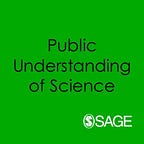Queering Science Communication — Representations, Theory, and Practice
Review by Shaun O’Boyle
Queering Science Communication seamlessly incorporates practice spotlights into each section. For me, the most successful spotlights were those where the author(s) had taken time to reflect critically on their process, and to share what they learned with the reader.
This book, the first in the publisher’s Contemporary Issues in Science Communication series, explores what it means to queer science communication — as I see it, to challenge existing power structures and to look at science communication through a queer lens. The book helps create a new space in the science communication literature, exploring the intersections between science communication and queer theory, culture, history, community, art, entertainment, experiences, and more. Before now, I hadn’t really seen scholarship and analysis like this, despite following so much of the incredible work being done by LGBTQ+ science communication researchers and practitioners. Queering Science Communication is an important and significant step towards better recognition and context for that work.
I was at an event recently that combined music and performance with stories about LGBTQ+ scientists, presented by scientist, science communicator and drag queen Sassy Science. The night was filled with songs, humour, joy, and stories about LGBTQ+ scientists. (I even joined her on stage at one point to take a supporting role in a performance of 9 to 5 by Dolly Parton.) It was a science drag show and it wasn’t even my first science drag show, because I am blessed to be a scientist who is also part of the LGBTQ+ community. I help organise queer science communication events every November for the International Day of LGBTQ+ People in STEM, so the relationship between science and my community is a big part of my life, but it hasn’t been a big part of the science communication literature I read.
The book is divided into four sections around different themes. In each section, there are longer research-focused chapters and shorter practice spotlights — so it represents researchers, practitioners, and those of us who are a combination of the two. There are teaching notes at the end of each section, and I found the tasks and prompts in these notes useful for reflecting on my own practice.
The LGBTQ+ community has a complex relationship with science and science communication. This is outlined in a strong opening chapter by Aritra Chatterjee that provides important context for the rest of the book. Throughout the book, these longer research chapters contain many moments of important and useful scholarship; the authors seem mindful that there are many routes to science communication, and not every reader will be familiar with their discipline and methodology. Eleanor S. Armstrong and Simon J. Lock, for example, consider the queering of science museums, science centres, and other public science institutions. In doing so, they make existing scholarship on the queering of museums relevant and understandable to the science communication sector.
My favourite chapter, as a Star Trek Discovery fan, was by editor Lindy A. Orthia and Leo P. Visser, exploring queer characters in science-themed fiction. Not only was this chapter an opportunity to spend time with characters that I love, it was a compelling way to unravel so many of those intersections between science communication and queerness. Again, this was written in a way that I could follow and connect with, even though I don’t have any formal training in the humanities.
Queering Science Communication seamlessly incorporates practice spotlights into each section. For me, the most successful spotlights were those where the author(s) had taken time to reflect critically on their process, and to share what they learned with the reader. Josh Davis’s description of the first LGBTQ+ Natural History tour of The Natural History Museum in London captures an important moment in queer science communication and it also provides valuable insights, for example, that exploring the queer side of nature can help us challenge assumptions and how we define ‘normal’. Some spotlights were less reflective, but they help form a record of valuable initiatives.
One of the main strengths of Queering Science Communication is the careful curation and framing of the content by the editors. Their introduction and conclusion provide context for the work, and help bridge the gap between the once distant disciplines of queer studies and science communication. The content is also very well curated and filled with unexpected angles on science communication. While the book touches on inclusion, it goes far beyond that, focusing on the unique perspectives queer people have on science communication.
Roberson and Orthia emphasise that there is more work to do, and I think this book will pave the way for a lot of that work. Their book has made me realise just how much I want to understand how science communication can be influenced by queer culture, joy, community, art, creativity, diversity, activism, and liberation.
Shaun O’Boyle, PhD in biochemistry, is a science communicator working across museums, education, and broadcasting. He is a research fellow at Dublin City University, Ireland, exploring museum and art-science approaches to co-creation in scientific research. He is co-editor with Dr Alfredo Carpineti of The Queer Variable, a collection of interviews with LGBTQ+ people in STEM, published by Pride in Stem.
